The Cambridge History of China. Vol. 06. Alien Regimes and Border States, 907-1368
Подождите немного. Документ загружается.

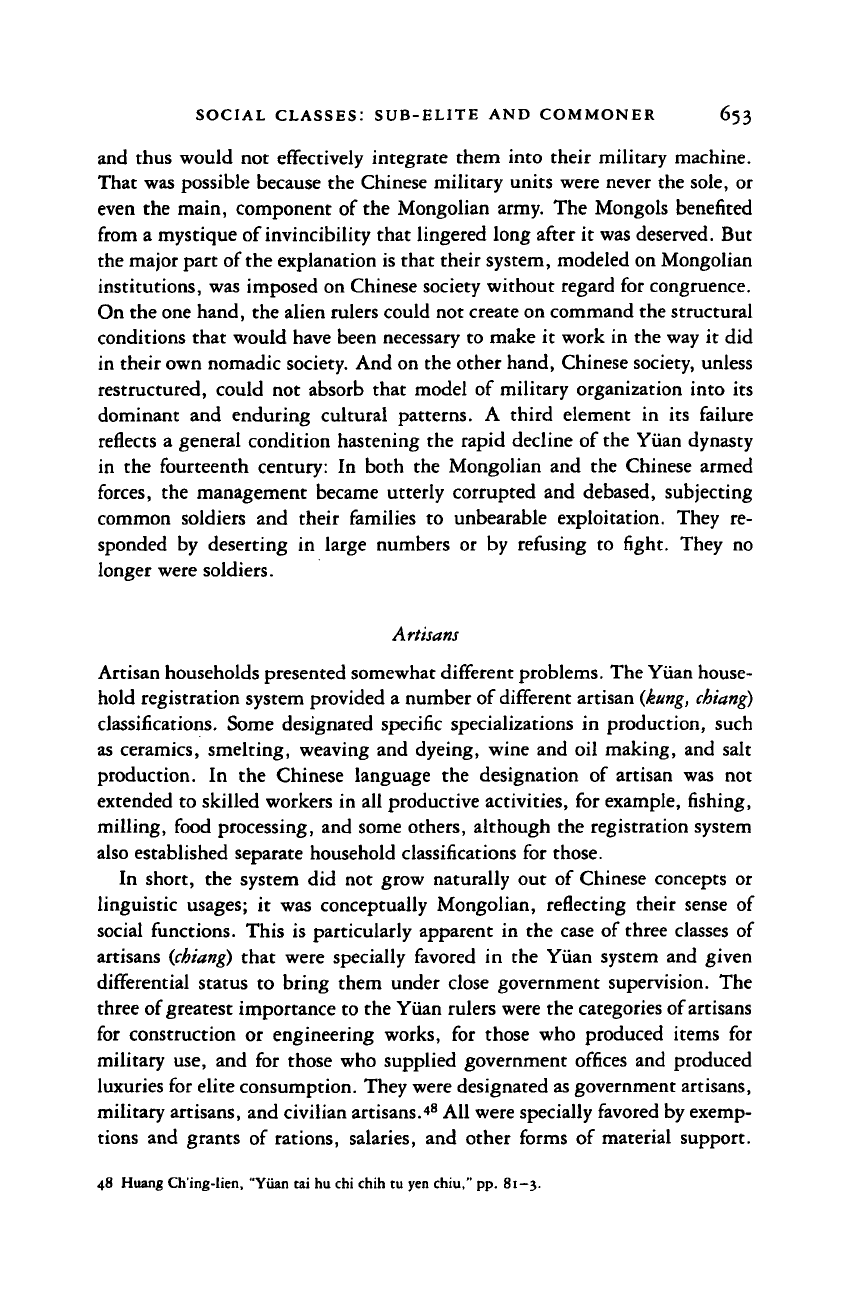
SOCIAL CLASSES: SUB-ELITE AND COMMONER 653
and thus would not effectively integrate them into their military machine.
That was possible because the Chinese military units were never the sole, or
even the main, component of the Mongolian army. The Mongols benefited
from a mystique of invincibility that lingered long after it was deserved. But
the major part of the explanation is that their system, modeled on Mongolian
institutions, was imposed on Chinese society without regard for congruence.
On the one hand, the alien rulers could not create on command the structural
conditions that would have been necessary to make it work in the way it did
in their own nomadic society. And on the other hand, Chinese society, unless
restructured, could not absorb that model of military organization into its
dominant and enduring cultural patterns. A third element in its failure
reflects a general condition hastening the rapid decline of the Yiian dynasty
in the fourteenth century: In both the Mongolian and the Chinese armed
forces, the management became utterly corrupted and debased, subjecting
common soldiers and their families to unbearable exploitation. They re-
sponded by deserting in large numbers or by refusing to fight. They no
longer were soldiers.
Artisans
Artisan households presented somewhat different problems. The Yiian house-
hold registration system provided a number of different artisan
(kung,
chiang)
classifications. Some designated specific specializations in production, such
as ceramics, smelting, weaving and dyeing, wine and oil making, and salt
production. In the Chinese language the designation of artisan was not
extended to skilled workers in all productive activities, for example, fishing,
milling, food processing, and some others, although the registration system
also established separate household classifications for those.
In short, the system did not grow naturally out of Chinese concepts or
linguistic usages; it was conceptually Mongolian, reflecting their sense of
social functions. This is particularly apparent in the case of three classes of
artisans
{chiang)
that were specially favored in the Yiian system and given
differential status to bring them under close government supervision. The
three of greatest importance to the Yiian rulers were the categories of artisans
for construction or engineering works, for those who produced items for
military use, and for those who supplied government offices and produced
luxuries for elite consumption. They were designated
as
government artisans,
military artisans, and civilian artisans.
48
All were specially favored by exemp-
tions and grants of rations, salaries, and other forms of material support.
48 Huang Ch'ing-lien, "Yiian tai hu chi chih tu yen chiu," pp. 81—3.
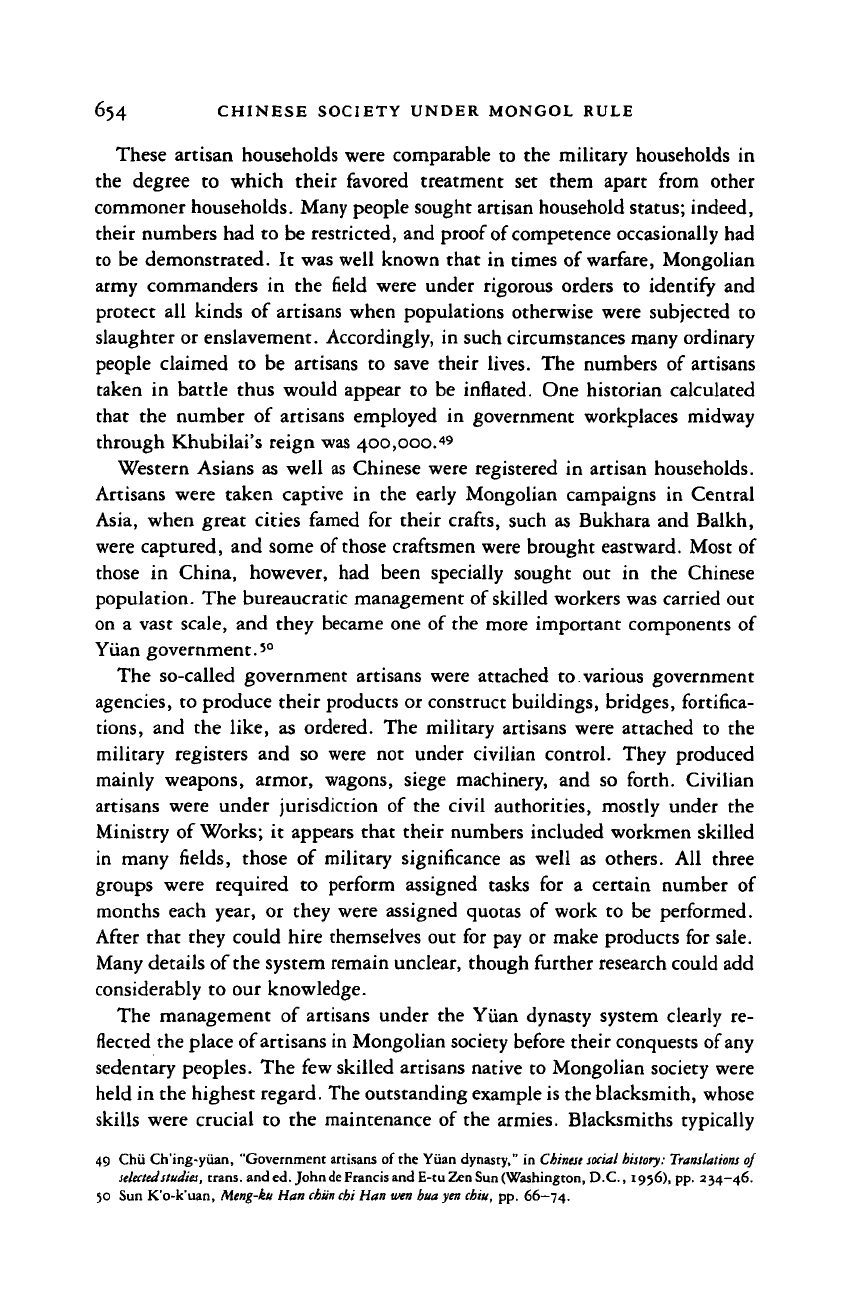
654 CHINESE SOCIETY UNDER MONGOL RULE
These artisan households were comparable to the military households in
the degree to which their favored treatment set them apart from other
commoner households. Many people sought artisan household status; indeed,
their numbers had to be restricted, and proof of competence occasionally had
to be demonstrated. It was well known that in times of warfare, Mongolian
army commanders in the field were under rigorous orders to identify and
protect all kinds of artisans when populations otherwise were subjected to
slaughter or enslavement. Accordingly, in such circumstances many ordinary
people claimed to be artisans to save their lives. The numbers of artisans
taken in battle thus would appear to be inflated. One historian calculated
that the number of artisans employed in government workplaces midway
through Khubilai's reign was 400,000.
49
Western Asians as well as Chinese were registered in artisan households.
Artisans were taken captive in the early Mongolian campaigns in Central
Asia, when great cities famed for their crafts, such as Bukhara and Balkh,
were captured, and some of those craftsmen were brought eastward. Most of
those in China, however, had been specially sought out in the Chinese
population. The bureaucratic management of skilled workers was carried out
on a vast scale, and they became one of the more important components of
Yuan government.
50
The so-called government artisans were attached to various government
agencies, to produce their products or construct buildings, bridges, fortifica-
tions,
and the like, as ordered. The military artisans were attached to the
military registers and so were not under civilian control. They produced
mainly weapons, armor, wagons, siege machinery, and so forth. Civilian
artisans were under jurisdiction of the civil authorities, mostly under the
Ministry of
Works;
it appears that their numbers included workmen skilled
in many fields, those of military significance as well as others. All three
groups were required to perform assigned tasks for a certain number of
months each year, or they were assigned quotas of work to be performed.
After that they could hire themselves out for pay or make products for sale.
Many details of
the
system remain unclear, though further research could add
considerably to our knowledge.
The management of artisans under the Yuan dynasty system clearly re-
flected the place of artisans in Mongolian society before their conquests of any
sedentary peoples. The few skilled artisans native to Mongolian society were
held in the highest regard. The outstanding example is the blacksmith, whose
skills were crucial to the maintenance of the armies. Blacksmiths typically
49 Chii Ch'ing-yiian, "Government artisans of the Yuan dynasty," in
Chinese social
history:
Translations of
selected
studies,
trans, and ed. John
de
Francis and E-tu Zen Sun (Washington, D.C., 1956), pp. 234-46.
50 Sun K'o-k'uan,
Meng-ku
Han
chiin chi
Han
wen hua yen
chiu,
pp. 66—74.
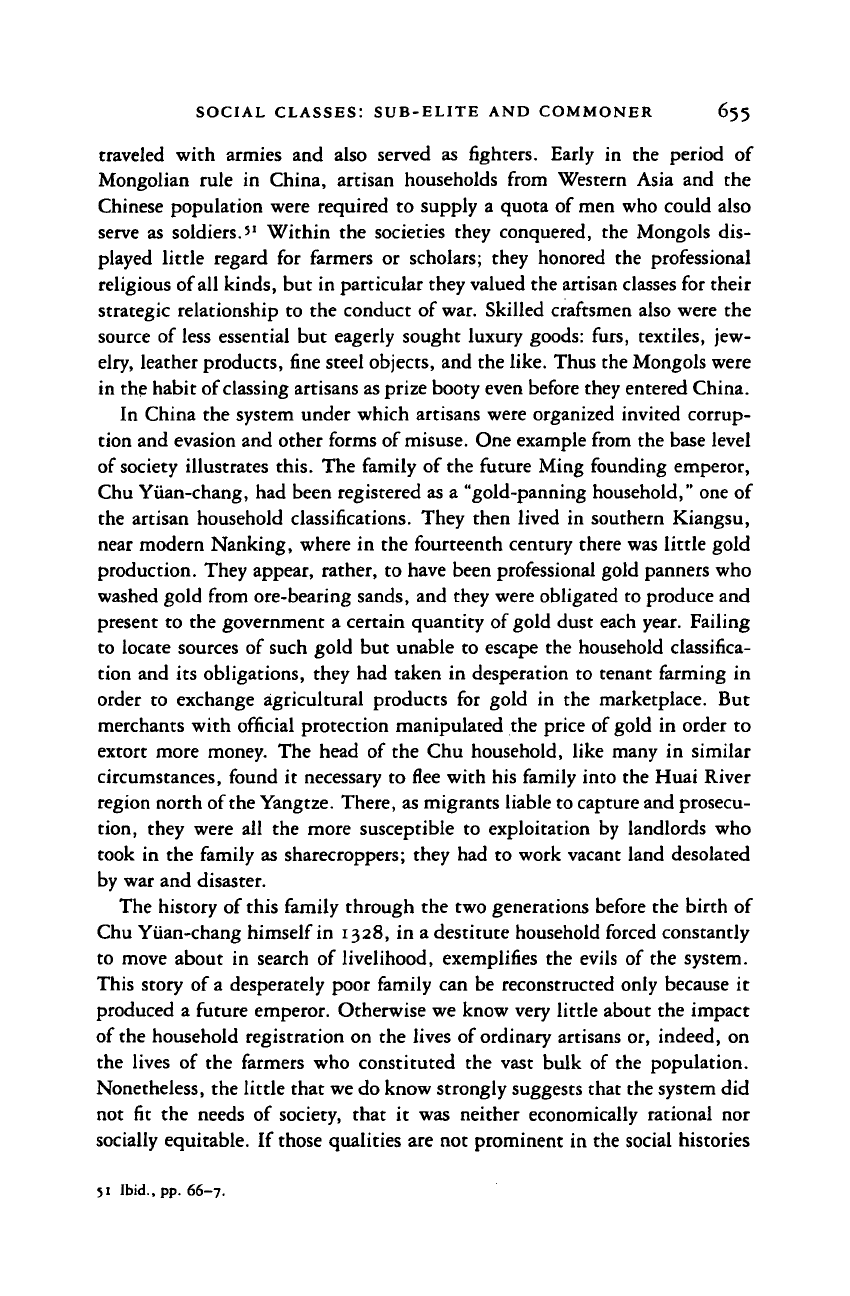
SOCIAL CLASSES: SUB-ELITE AND COMMONER 655
traveled with armies and also served as fighters. Early in the period of
Mongolian rule in China, artisan households from Western Asia and the
Chinese population were required to supply a quota of men who could also
serve as soldiers.'
1
Within the societies they conquered, the Mongols dis-
played little regard for farmers or scholars; they honored the professional
religious of
all
kinds, but in particular they valued the artisan classes for their
strategic relationship to the conduct of war. Skilled craftsmen also were the
source of less essential but eagerly sought luxury goods: furs, textiles, jew-
elry, leather products, fine steel objects, and the like. Thus the Mongols were
in the habit of classing artisans as prize booty even before they entered China.
In China the system under which artisans were organized invited corrup-
tion and evasion and other forms of misuse. One example from the base level
of society illustrates this. The family of the future Ming founding emperor,
Chu Yuan-chang, had been registered as a "gold-panning household," one of
the artisan household classifications. They then lived in southern Kiangsu,
near modern Nanking, where in the fourteenth century there was little gold
production. They appear, rather, to have been professional gold panners who
washed gold from ore-bearing sands, and they were obligated to produce and
present to the government a certain quantity of gold dust each year. Failing
to locate sources of such gold but unable to escape the household classifica-
tion and its obligations, they had taken in desperation to tenant farming in
order to exchange agricultural products for gold in the marketplace. But
merchants with official protection manipulated the price of gold in order to
extort more money. The head of the Chu household, like many in similar
circumstances, found it necessary to flee with his family into the Huai River
region north of the Yangtze. There, as migrants liable to capture and prosecu-
tion, they were all the more susceptible to exploitation by landlords who
took in the family as sharecroppers; they had to work vacant land desolated
by war and disaster.
The history of this family through the two generations before the birth of
Chu Yuan-chang himself in 1328, in a destitute household forced constantly
to move about in search of livelihood, exemplifies the evils of the system.
This story of a desperately poor family can be reconstructed only because it
produced a future emperor. Otherwise we know very little about the impact
of the household registration on the lives of ordinary artisans or, indeed, on
the lives of the farmers who constituted the vast bulk of the population.
Nonetheless, the little that we do know strongly suggests that the system did
not fit the needs of society, that it was neither economically rational nor
socially equitable. If those qualities are not prominent in the social histories
51 Ibid., pp. 66—7.
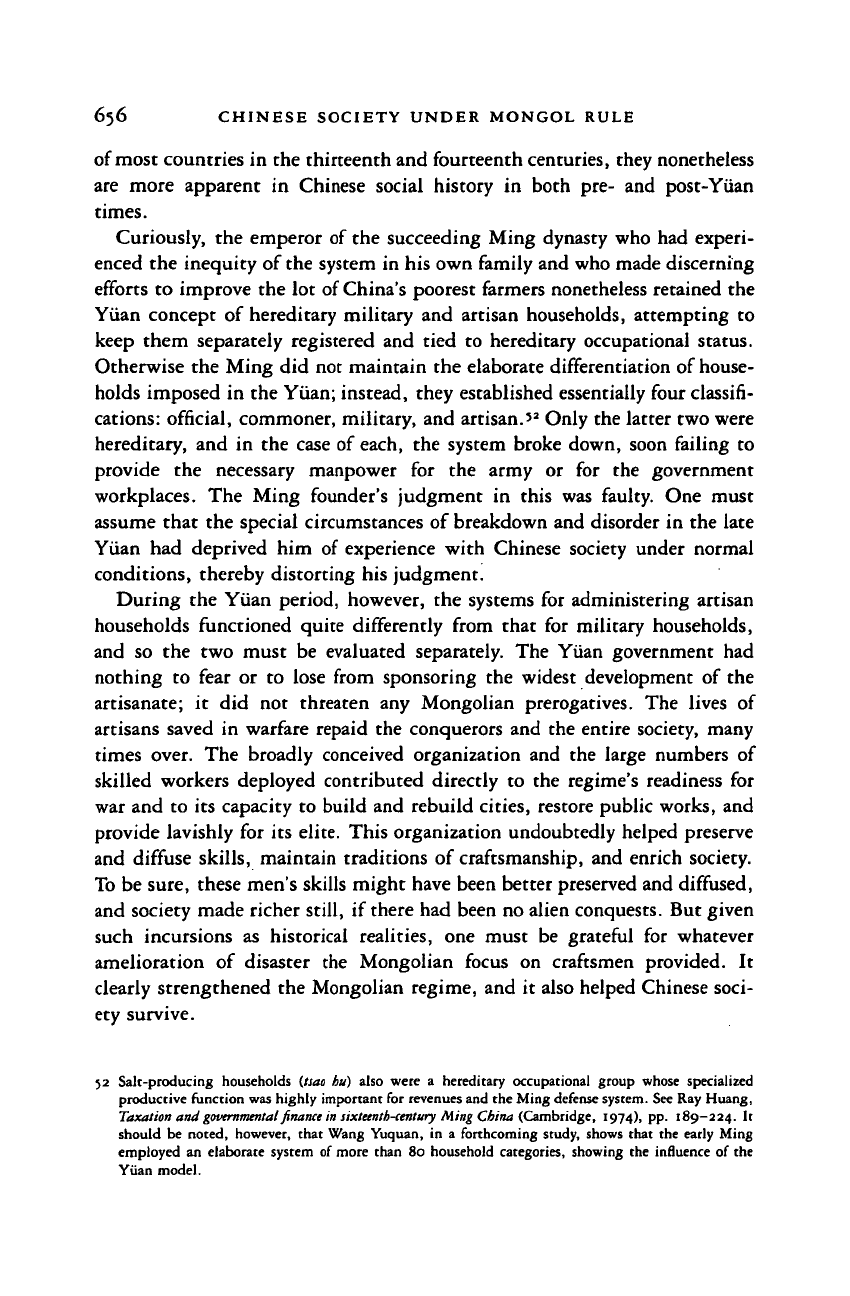
656 CHINESE SOCIETY UNDER MONGOL RULE
of most countries in the thirteenth and fourteenth centuries, they nonetheless
are more apparent in Chinese social history in both pre- and post-Yuan
times.
Curiously, the emperor of the succeeding Ming dynasty who had experi-
enced the inequity of the system in his own family and who made discerning
efforts to improve the lot of China's poorest farmers nonetheless retained the
Yuan concept of hereditary military and artisan households, attempting to
keep them separately registered and tied to hereditary occupational status.
Otherwise the Ming did not maintain the elaborate differentiation of house-
holds imposed in the Yuan; instead, they established essentially four classifi-
cations: official, commoner, military, and artisan.
52
Only the latter two were
hereditary, and in the case of each, the system broke down, soon failing to
provide the necessary manpower for the army or for the government
workplaces. The Ming founder's judgment in this was faulty. One must
assume that the special circumstances of breakdown and disorder in the late
Yuan had deprived him of experience with Chinese society under normal
conditions, thereby distorting his judgment.
During the Yuan period, however, the systems for administering artisan
households functioned quite differently from that for military households,
and so the two must be evaluated separately. The Yuan government had
nothing to fear or to lose from sponsoring the widest development of the
artisanate; it did not threaten any Mongolian prerogatives. The lives of
artisans saved in warfare repaid the conquerors and the entire society, many
times over. The broadly conceived organization and the large numbers of
skilled workers deployed contributed directly to the regime's readiness for
war and to its capacity to build and rebuild cities, restore public works, and
provide lavishly for its elite. This organization undoubtedly helped preserve
and diffuse skills, maintain traditions of craftsmanship, and enrich society.
To be sure, these men's skills might have been better preserved and diffused,
and society made richer still, if there had been no alien conquests. But given
such incursions as historical realities, one must be grateful for whatever
amelioration of disaster the Mongolian focus on craftsmen provided. It
clearly strengthened the Mongolian regime, and it also helped Chinese soci-
ety survive.
52 Salt-producing households (tsao hu) also were a hereditary occupational group whose specialized
productive function was highly important for revenues and the Ming defense system. See Ray Huang,
Taxation and
governmental
finance
in
sixteenth-century
Ming China (Cambridge, 1974), pp. 189—224. It
should be noted, however, that Wang Yuquan, in a forthcoming study, shows that the early Ming
employed an elaborate system of more than 80 household categories, showing the influence of the
Yuan model.
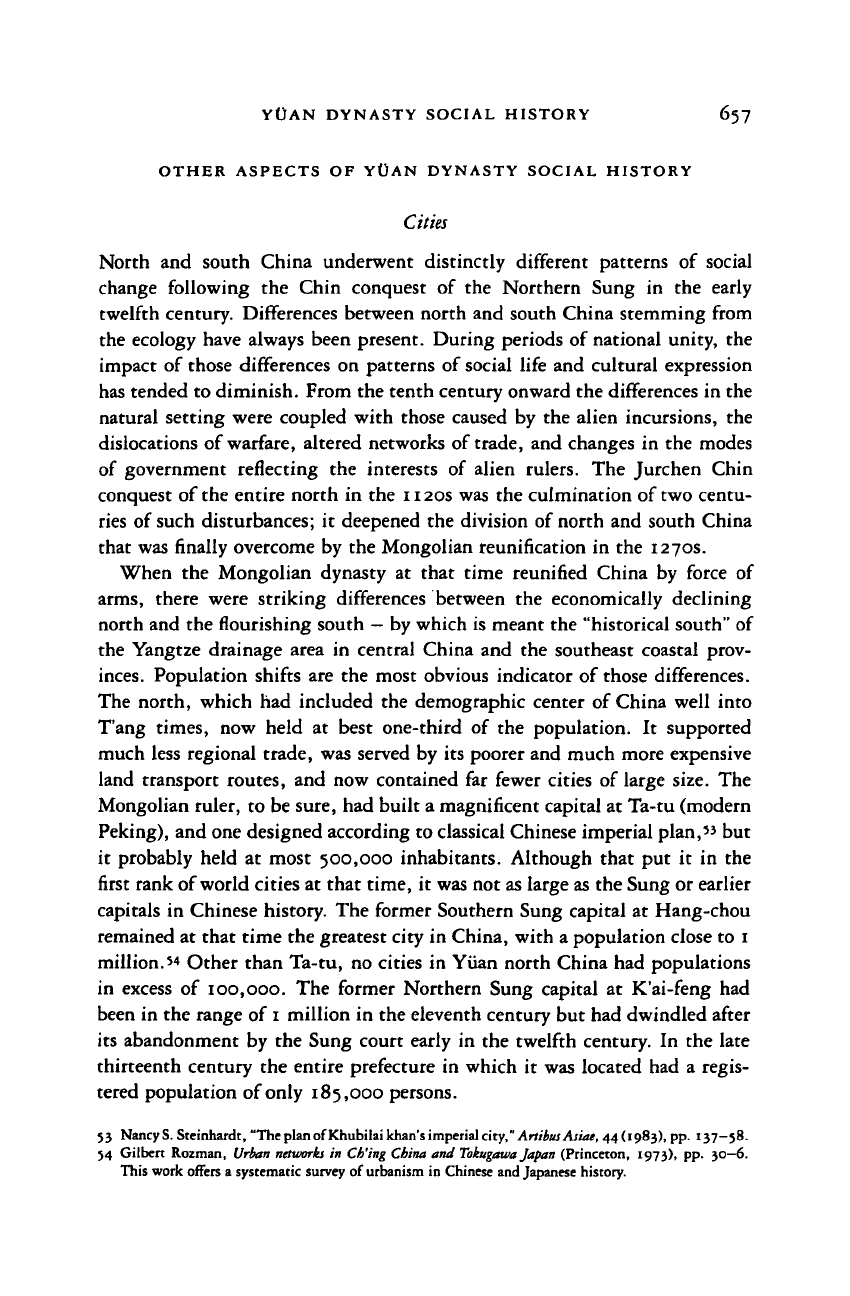
YOAN DYNASTY SOCIAL HISTORY 657
OTHER ASPECTS OF YOAN DYNASTY SOCIAL HISTORY
Cities
North and south China underwent distinctly different patterns of social
change following the Chin conquest of the Northern Sung in the early
twelfth century. Differences between north and south China stemming from
the ecology have always been present. During periods of national unity, the
impact of those differences on patterns of social life and cultural expression
has tended to diminish. From the tenth century onward the differences in the
natural setting were coupled with those caused by the alien incursions, the
dislocations of warfare, altered networks of trade, and changes in the modes
of government reflecting the interests of alien rulers. The Jurchen Chin
conquest of the entire north in the 1120s was the culmination of two centu-
ries of such disturbances; it deepened the division of north and south China
that was finally overcome by the Mongolian reunification in the 1270s.
When the Mongolian dynasty at that time reunified China by force of
arms,
there were striking differences between the economically declining
north and the flourishing south - by which is meant the "historical south" of
the Yangtze drainage area in central China and the southeast coastal prov-
inces.
Population shifts are the most obvious indicator of those differences.
The north, which had included the demographic center of China well into
T'ang times, now held at best one-third of the population. It supported
much less regional trade, was served by its poorer and much more expensive
land transport routes, and now contained far fewer cities of large size. The
Mongolian ruler, to be sure, had built a magnificent capital at Ta-tu (modern
Peking), and one designed according to classical Chinese imperial plan," but
it probably held at most 500,000 inhabitants. Although that put it in the
first rank of world cities at that time, it was not as large as the Sung or earlier
capitals in Chinese history. The former Southern Sung capital at Hang-chou
remained at that time the greatest city in China, with a population close to 1
million.
54
Other than Ta-tu, no cities in Yuan north China had populations
in excess of 100,000. The former Northern Sung capital at K'ai-feng had
been in the range of
1
million in the eleventh century but had dwindled after
its abandonment by the Sung court early in the twelfth century. In the late
thirteenth century the entire prefecture in which it was located had a regis-
tered population of only 185,000 persons.
53 NancyS. Steinhardt, "TheplanofKhubilai khan'simperiaJ city,"
Ar»;A/u
Afi<K, 44(1983), pp. 137—58.
54 Gilben Rozman, Urban networks in Ch'ing China and Toiugawa Japan (Princeton, 1973), pp. 30—6.
This work offers a systematic survey of urbanism in Chinese and Japanese history.
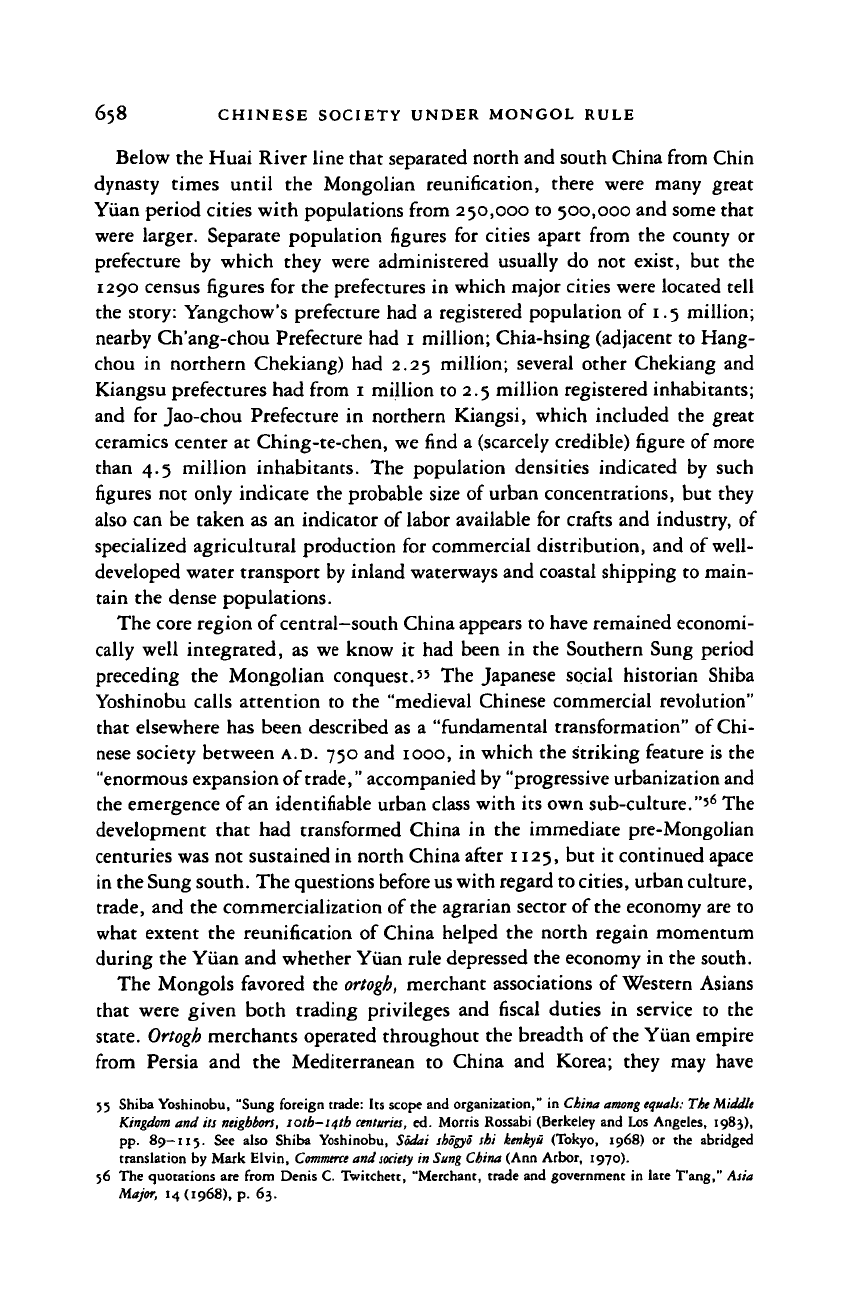
658 CHINESE SOCIETY UNDER MONGOL RULE
Below the Huai River line that separated north and south China from Chin
dynasty times until the Mongolian reunification, there were many great
Yuan period cities with populations from 250,000 to 500,000 and some that
were larger. Separate population figures for cities apart from the county or
prefecture by which they were administered usually do not exist, but the
1290 census figures for the prefectures in which major cities were located tell
the story: Yangchow's prefecture had a registeted population of 1.5 million;
nearby Ch'ang-chou Prefecture had 1 million; Chia-hsing (adjacent to Hang-
chou in northern Chekiang) had 2.25 million; several other Chekiang and
Kiangsu prefectures had from 1 million to 2.5 million registered inhabitants;
and for Jao-chou Prefecture in northern Kiangsi, which included the great
ceramics center at Ching-te-chen, we find a (scarcely credible) figure of more
than 4.5 million inhabitants. The population densities indicated by such
figures not only indicate the probable size of urban concentrations, but they
also can be taken as an indicator of labor available for crafts and industry, of
specialized agricultural production for commercial distribution, and of well-
developed water transport by inland waterways and coastal shipping to main-
tain the dense populations.
The core region of central—south China appears to have remained economi-
cally well integrated, as we know it had been in the Southern Sung period
preceding the Mongolian conquest." The Japanese social historian Shiba
Yoshinobu calls attention to the "medieval Chinese commercial revolution"
that elsewhere has been described as a "fundamental transformation" of Chi-
nese society between
A.D.
750 and 1000, in which the striking feature is the
"enormous expansion of trade," accompanied by "progressive urbanization and
the emergence of an identifiable urban class with its own sub-culture."'
6
The
development that had transformed China in the immediate pre-Mongolian
centuries was not sustained in north China after 1125, but it continued apace
in the Sung south. The questions before
us
with regard to
cities,
urban culture,
trade, and the commercialization of the agrarian sector of the economy are to
what extent the reunification of China helped the north regain momentum
during the Yuan and whether Yuan rule depressed the economy in the south.
The Mongols favored the
ortogh,
merchant associations of Western Asians
that were given both trading privileges and fiscal duties in service to the
state.
Ortogh
merchants operated throughout the breadth of the Yuan empire
from Persia and the Mediterranean to China and Korea; they may have
55 Shiba Yoshinobu, "Sung foreign trade: Its scope and organization," in China
among
equals:
The Middle
Kingdom and its
neighbors,
loth-iqth
centuries,
ed. Morris Rossabi (Berkeley and Los Angeles, 1983),
pp.
89—11;.
See also Shiba Yoshinobu, Sodai shogyo shi tenkyu (Tokyo, 1968) or the abridged
translation by Mark Elvin,
Commerce
and
society
in Sung China (Ann Arbor, 1970).
56 The quotations are from Denis C. Twitchett, "Merchant, trade and government in late T'ang," Asia
Major, 14 (1968), p. 63.
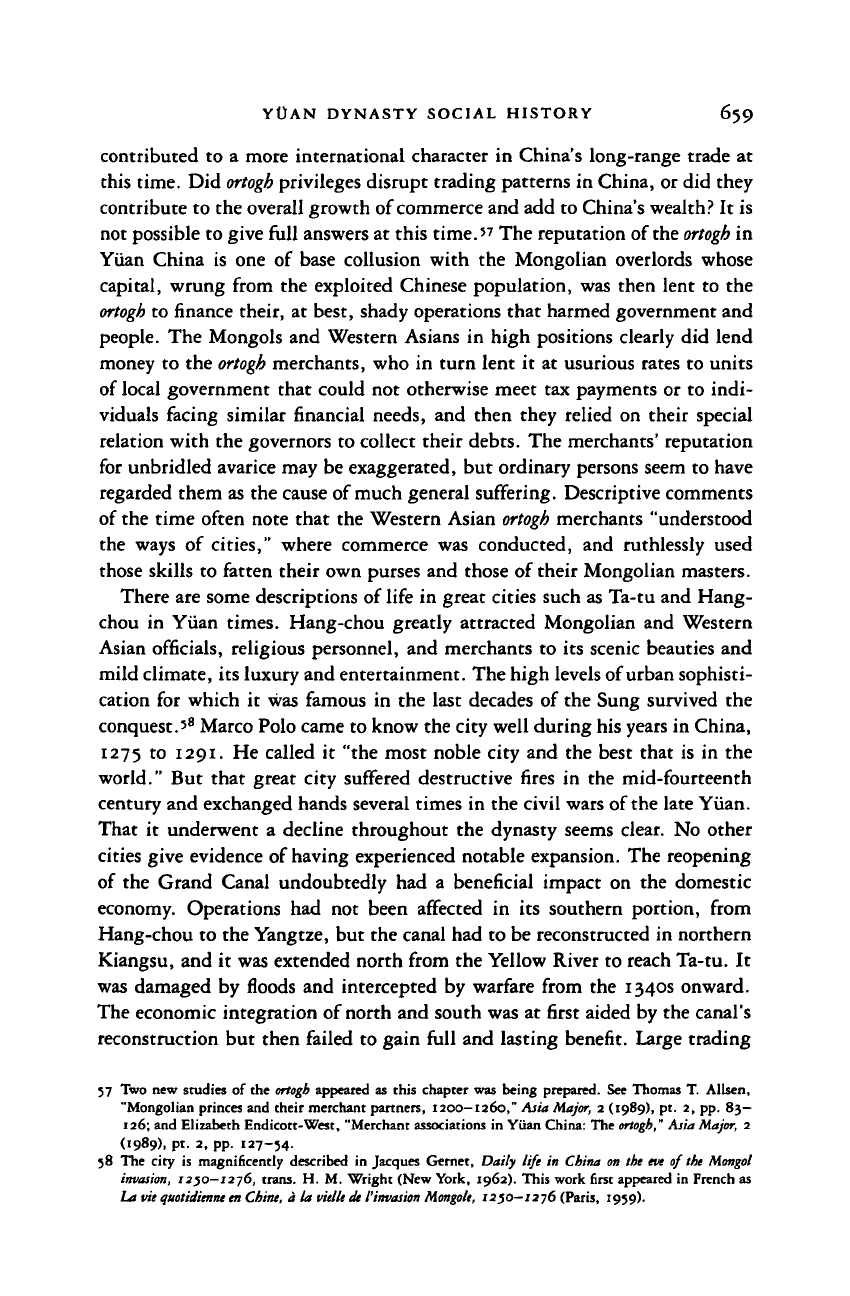
YOAN DYNASTY SOCIAL HISTORY 659
contributed to a more international character in China's long-range trade at
this time. Did
ortogh
privileges disrupt trading patterns in China, or did they
contribute to the overall growth of commerce and add to China's wealth? It is
not possible to give full answers at this time.
57
The reputation of
the ortogh
in
Yuan China is one of base collusion with the Mongolian overlords whose
capital, wrung from the exploited Chinese population, was then lent to the
ortogh
to
finance
their, at best, shady operations that harmed government and
people. The Mongols and Western Asians in high positions clearly did lend
money to the
ortogh
merchants, who in turn lent it at usurious rates to units
of local government that could not otherwise meet tax payments or to indi-
viduals facing similar financial needs, and then they relied on their special
relation with the governors to collect their debts. The merchants' reputation
for unbridled avarice may be exaggerated, but ordinary persons seem to have
regarded them as the cause of much general suffering. Descriptive comments
of the time often note that the Western Asian
ortogh
merchants "understood
the ways of cities," where commerce was conducted, and ruthlessly used
those skills to fatten their own purses and those of their Mongolian masters.
There are some descriptions of life in great cities such as Ta-tu and Hang-
chou in Yuan times. Hang-chou greatly attracted Mongolian and Western
Asian officials, religious personnel, and merchants to its scenic beauties and
mild climate, its luxury and entertainment. The high levels of urban sophisti-
cation for which it was famous in the last decades of the Sung survived the
conquest.'
8
Marco Polo came to know the city well during his years in China,
1275 to 1291. He called it "the most noble city and the best that is in the
world." But that great city suffered destructive fires in the mid-fourteenth
century and exchanged hands several times in the civil wars of
the
late Yuan.
That it underwent a decline throughout the dynasty seems clear. No other
cities give evidence of having experienced notable expansion. The reopening
of the Grand Canal undoubtedly had a beneficial impact on the domestic
economy. Operations had not been affected in its southern portion, from
Hang-chou to the Yangtze, but the canal had to be reconstructed in northern
Kiangsu, and it was extended north from the Yellow River to reach Ta-tu. It
was damaged by floods and intercepted by warfare from the 1340s onward.
The economic integration of north and south was at first aided by the canal's
reconstruction but then failed to gain full and lasting benefit. Large trading
57 Two new studies of the
ortogh
appeared as this chapter was being prepared. See Thomas T. Allsen,
"Mongolian princes and their merchant partners, 1200—1260," Asia Major, 2 (1989), pt. 2, pp. 83—
126;
and Elizabeth Endicott-West, "Merchant associations in Yuan China: The ortogh" Asia Major, 2
(1989),
pt. 2, pp. 127-54.
58 The city is magnificently described in Jacques Gemet, Daily life in China on the eve of the Mongol
invasion, 7230-1276, trans. H. M. Wright (New York, 1962). This work first appeared in French as
La vie quotiditnne
en
Chine, a la
vielle
de
I'invasion
Mongole,
I2}o—i2j6 (Paris, 1959).

660 CHINESE SOCIETY UNDER MONGOL RULE
cities along its northern portion revived but did not flourish. No sector of the
economy appears
to
have genuinely flourished during Yiian times, but there
was
a
wide variation
in
regional conditions.
Some
of
the most direct and colorful information about the life of urban
China
in
Yiian times comes from
the
Yiian dramas
(tsa-chii),
whose social
history we have already discussed. Many of those depict the lives of ordinary
persons
in
familiar settings, and although their plots may
be
fanciful,
the
dramas nonetheless reveal a wide range of urban pursuits, show the interac-
tion
of
urban and rural life, expose us
to
the cycle of festivals and religious
observances that punctuated
the
year, and depict the attitudes toward rich
and poor, toward officials,
and
occasionally toward aliens then resident
in
China. Some of the dramas have been well translated, but their analysis as
a
resource for the study of Yiian society is as yet only beginning.
59
The same is
true
of
the great compendium
of
case law
and
precedents,
the
Yiian tien
chang,
and other kinds of documentation of
Yiian
social history.
60
Rural life
If our knowledge of urban society is inadequate, the situation with regard
to
the lives of the vast majority of
all
Chinese, the village-dwelling farmers and
small craftsmen
and
traders who constituted
the
rural sector
of
society,
is
even less satisfactory. The dramas, informal notes and sketches
(pi-chi),
and
other unofficial
and
informal kinds
of
historical source materials
are
less
frequently informative about rural life than about urban life,
or
about
the
elite
in
various settings. Nonetheless, the possibility exists for developing
a
much more detailed understanding of some aspects of rural society than has
yet emerged.
The base level of government was built
on
two systems
of
local manage-
ment derived from earlier Chinese practice.
At
the beginning of Khubilai's
reign, his government ordered that the various categories
of
households
be
brought under local supervision.
In
cities and towns and their immediate
suburbs, as well as in rural areas, the households were organized into what we
might call wards,
or
precincts,
for
which
a
variety of Chinese names were
used, differently designated
in
different parts
of
the country. Their heads,
nominally chosen by acclamation, appear
in
fact
to
have been selected with
county government concurrence from among
the
largest taxpayers. Their
59 See George
A.
Hayden, Crime and punhbmtnl
in
medieval
Chinese
drama: Three Judge
Pao
plays, Harvard
East Asian Monograph
no. 82
(Cambridge, Mass., 1978). This work uses courtroom dramas
to
explore concepts of social justice. Many
of
the Yiian dramas have now been translated.
60 For a comment on studies
of
the
Yuan
tien
chang,
see my "Note on traditional sources for Yiian history"
in this volume.
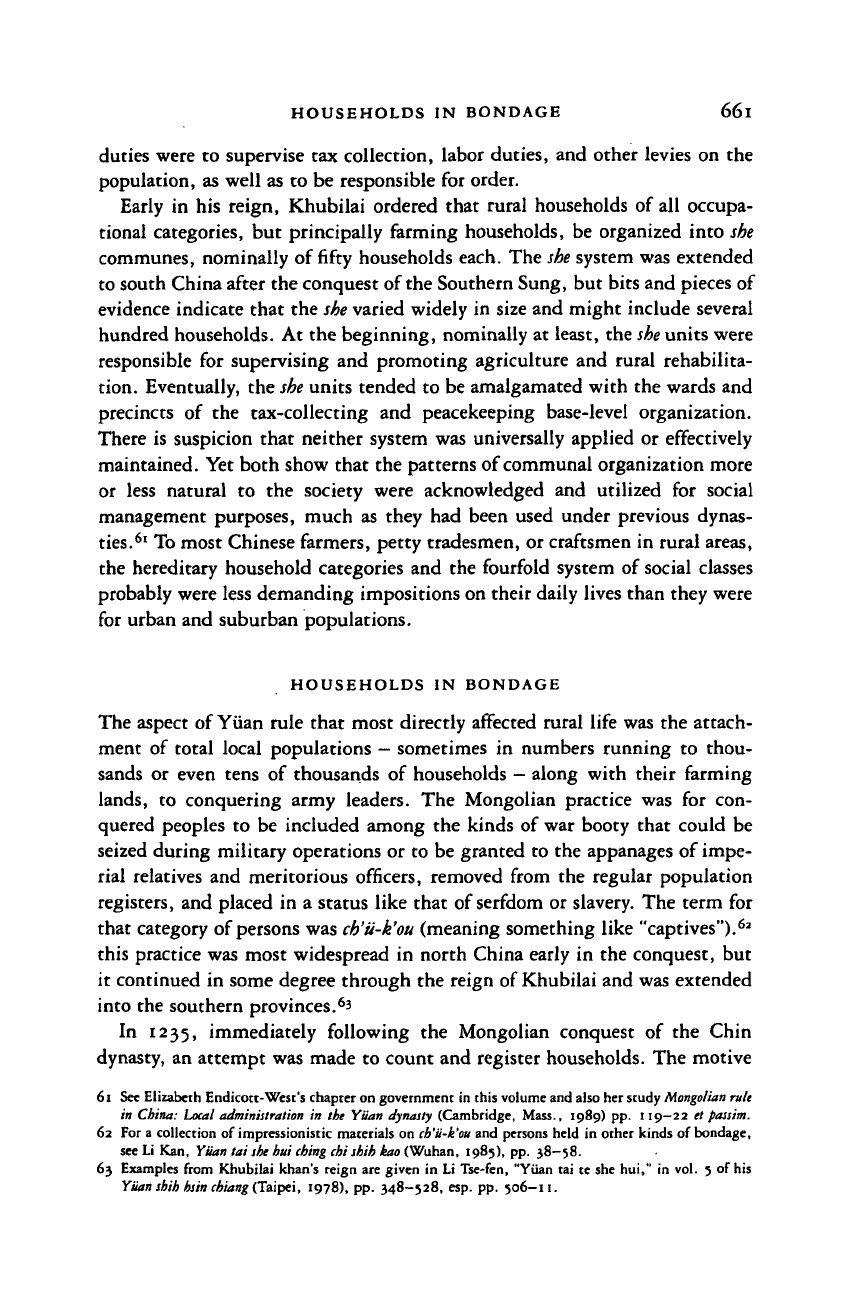
HOUSEHOLDS IN BONDAGE 66l
duties were
to
supervise tax collection, labor duties, and other levies
on the
population, as well as
to
be responsible for order.
Early
in his
reign, Khubilai ordered that rural households
of
all occupa-
tional categories,
but
principally farming households,
be
organized into she
communes, nominally
of
fifty households each. The
she
system was extended
to south China after the conquest of the Southern Sung, but bits and pieces of
evidence indicate that the
she
varied widely
in
size and might include several
hundred households.
At
the beginning, nominally
at
least, the
she
units were
responsible
for
supervising
and
promoting agriculture
and
rural rehabilita-
tion. Eventually, the
she
units tended
to
be amalgamated with the wards and
precincts
of the
tax-collecting
and
peacekeeping base-level organization.
There
is
suspicion that neither system was universally applied
or
effectively
maintained. Yet both show that the patterns of communal organization more
or less natural
to the
society were acknowledged
and
utilized
for
social
management purposes, much
as
they
had
been used under previous dynas-
ties.
6
'
To most Chinese farmers, petty tradesmen, or craftsmen
in
rural areas,
the hereditary household categories and the fourfold system
of
social classes
probably were less demanding impositions on their daily lives than they were
for urban and suburban populations.
HOUSEHOLDS IN BONDAGE
The aspect of Yuan rule that most directly affected rural life was the attach-
ment
of
total local populations
—
sometimes
in
numbers running
to
thou-
sands
or
even tens
of
thousands
of
households
—
along with their farming
lands,
to
conquering army leaders.
The
Mongolian practice
was for
con-
quered peoples
to be
included among
the
kinds
of
war booty that could
be
seized during military operations
or to
be granted
to
the appanages
of
impe-
rial relatives
and
meritorious officers, removed from
the
regular population
registers, and placed
in a
status like that
of
serfdom
or
slavery. The term
for
that category of persons was ch'ii-k'ou (meaning something like "captives").
62
this practice was most widespread
in
north China early
in
the conquest,
but
it continued
in
some degree through the reign of Khubilai and was extended
into the southern provinces.
63
In 1235, immediately following
the
Mongolian conquest
of the
Chin
dynasty, an attempt was made
to
count and register households. The motive
61 See Elizabeth Endicott-West's chapter on government in this volume and also her study Mongolian rule
in China: Local administration
in
the Yuan dynasty (Cambridge, Mass., 1989) pp. 119—22 et passim.
62 For a collection
of
impressionistic materials
on
ch'ii-k'ou
and persons held
in
other kinds
of
bondage,
see Li Kan, Yuan
tai
she
hut ching chi shih kao (Wuhan, 1985), pp. 38—58.
63 Examples from Khubilai khan's reign are given
in Li
Tse-fen, "Yuan
tai te
she hui,"
in
vol.
5 of
his
Yuan shih hsin
chiang
(Taipei, 1978), pp. 348—528, esp. pp. 506—11.
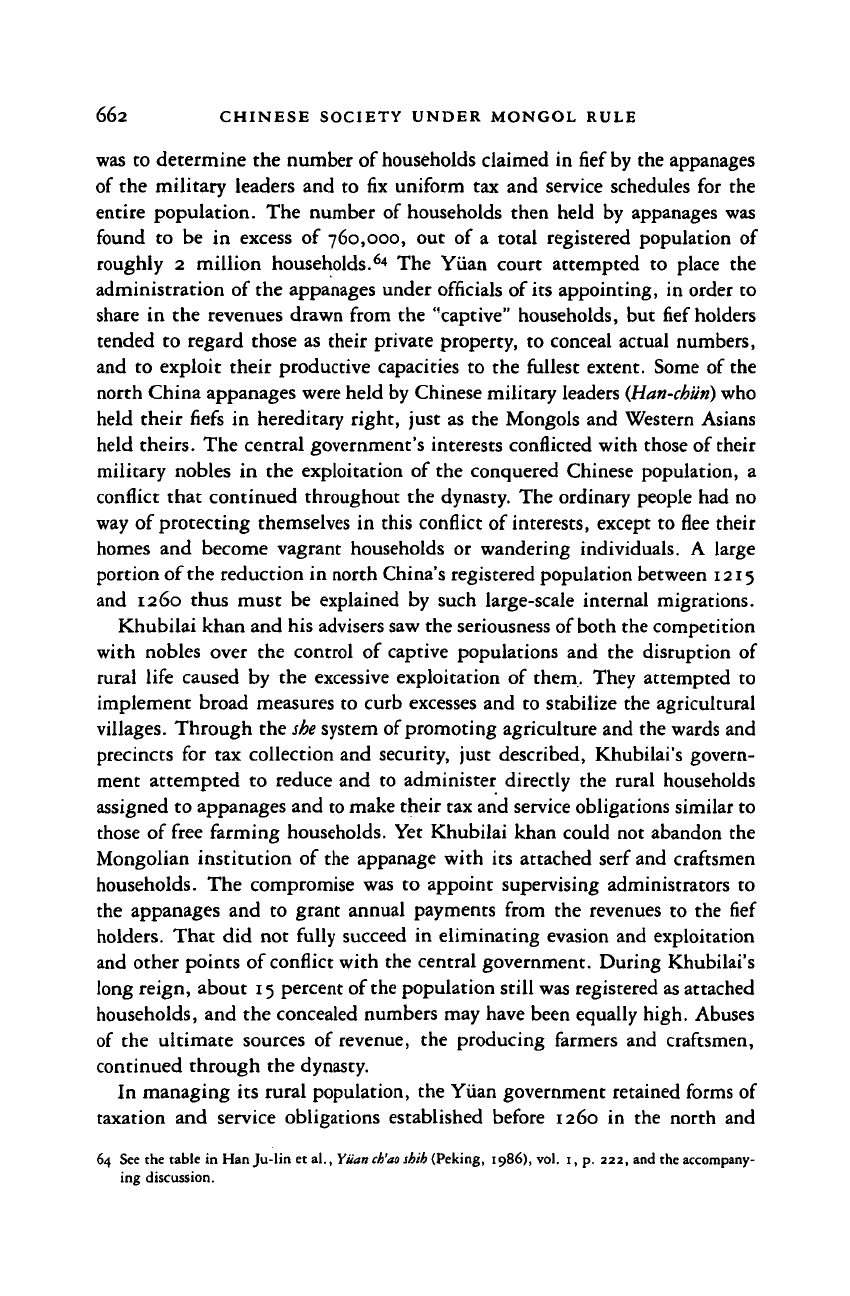
662 CHINESE SOCIETY UNDER MONGOL RULE
was
to
determine
the
number
of
households claimed
in
fief
by
the appanages
of the military leaders
and to fix
uniform
tax and
service schedules
for the
entire population.
The
number
of
households then held
by
appanages
was
found
to be in
excess
of
760,000,
out of a
total registered population
of
roughly
2
million households.
64
The
Yuan court attempted
to
place
the
administration
of
the appanages under officials
of
its appointing,
in
order
to
share
in the
revenues drawn from
the
"captive" households,
but
fief
holders
tended
to
regard those
as
their private property,
to
conceal actual numbers,
and
to
exploit their productive capacities
to the
fullest extent. Some
of
the
north China appanages were held by Chinese military leaders
{Han-chiin)
who
held their fiefs
in
hereditary right, just
as the
Mongols
and
Western Asians
held theirs. The central government's interests conflicted with those
of
their
military nobles
in the
exploitation
of
the conquered Chinese population,
a
conflict that continued throughout
the
dynasty. The ordinary people had
no
way
of
protecting themselves
in
this conflict
of
interests, except
to
flee
their
homes
and
become vagrant households
or
wandering individuals.
A
large
portion of the reduction
in
north China's registered population between 1215
and
1260
thus must
be
explained
by
such large-scale internal migrations.
Khubilai khan and his advisers saw the seriousness of both the competition
with nobles over
the
control
of
captive populations
and the
disruption
of
rural life caused
by the
excessive exploitation
of
them. They attempted
to
implement broad measures
to
curb excesses
and to
stabilize
the
agricultural
villages. Through the
she
system of promoting agriculture and the wards and
precincts
for tax
collection and security, just described, Khubilai's govern-
ment attempted
to
reduce
and to
administer directly
the
rural households
assigned
to
appanages and to make their tax and service obligations similar to
those
of
free farming households.
Yet
Khubilai khan could
not
abandon
the
Mongolian institution
of
the appanage with
its
attached serf and craftsmen
households.
The
compromise
was to
appoint supervising administrators
to
the appanages
and to
grant annual payments from
the
revenues
to the
fief
holders. That
did not
fully succeed
in
eliminating evasion
and
exploitation
and other points
of
conflict with the central government. During Khubilai's
long reign, about 15 percent of
the
population still was registered as attached
households,
and
the concealed numbers may have been equally high. Abuses
of
the
ultimate sources
of
revenue,
the
producing farmers
and
craftsmen,
continued through the dynasty.
In managing
its
rural population, the Yuan government retained forms of
taxation
and
service obligations established before
1260 in the
north
and
64 See the table
in
Han Ju-lin et al., Yiianch'aoshih(Peking, 1986), vol. i,p. 222, and the accompany-
ing discussion.
